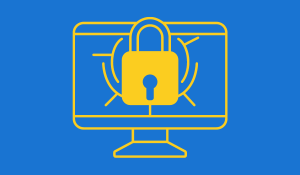Already a Client? Get support in 5 minutes or less. CONTACT SUPPORT NOW!
Top Tips for Working from Home and Succeeding

Subscribe to get updates!
Table of Contents

Cybersecurity Fundamentals Training
Endsight provides a complimentary cybersecurity training. Our goal is to bring awareness of the latest trends and best practices to help reduce cyber risk for our customers, our business community, and their families.
Although many employees have returned to an office setting, almost 13% of full-time employees continue to work remotely, and 28.2% are hybrid workers.
The number of remote workers is expected to rise gradually because 99% of workers prefer to work remotely for at least part of every work week. Add to that the fact that 16% of companies now are fully remote, and it’s easy to see remote work is here to stay.
The departure back to an office setting is motivated by management fears that when people work from home, “they slack off.” Productivity statistics vary widely – some studies show productivity declines of up to 19%, while others report productivity gains of up to 24%.
Managing and convincing higher-ups that you can both be at home and work productively can be difficult. As they say, the proof is in the pudding – i.e., experience – so we’ve developed a list of 27 hugely helpful working-from-home productivity tips. And those boring video meetings? We have some tips to make them better as well.
It’s not a vacation, so don’t treat it as one.
Working from home in your sweats may seem like a vacation, but it’s not. Keep these things in mind:
1. Keep your bedtime and morning rituals. Lay out your clothing the night before. Wake up early, get dressed, put on shoes, and do whatever you usually do during your commute – read, listen to music or a podcast, meditate, etc. Routines reduce stress and that surreal feeling you sometimes get from not being in an office.
2. Take breaks. Breaks are essential. They improve productivity, creativity, and focus and help prevent burnout. One helpful practice is the 50/10 method, which prescribes a 10-minute break every hour.
3. Set boundaries and expectations with others at home. Make sure your family knows what your work boundaries are. They should know your schedule, your workspace, and your end time.
4. Use plants and natural light. If you can put a plant in your workspace or sit next to a window, you’ll have a much more enjoyable time working. Nature is calming and reduces anxiety. If you can’t do either of these, take your breaks outside.
5. Get some exercise. Don’t just sit in the same position. Get out of that chair and stand up, stretch, or go for a short walk. You can even do push-ups to break up the day. In other words, variation in posture and movements helps your mind stay sharp.
6. Sign out of work at your assigned stopping point. This one is tough to do, especially if a work team constantly breaks this rule. Use your best judgment, but avoid initiating a text, email, or phone call way outside work hours. You will be doing your team a favor, as they, too, are trying to balance work and home life.
7. Find your ambiance. Some people work well with music, some with a TV running in the background, and some don't. If it works for you, OK. If it doesn't, then don't do it.
Stay professional
8. Commit to doing more. It would be best if you were crushing it working from home. Prove to your employer that you are more valuable when working from home than from the office. How else are you going to keep this privilege? Keep reading.
9. Create a separate workspace. To stay focused, separate work from play as much as possible. If you don’t have a dedicated room, turn a corner, closet, or portion of a room into a workspace. Keep your family out of it for the most part during work hours.
10. Dress for success. Forget "dress to impress. " Instead, dress for you. This is part of your morning routine. It would be best if you were dressed head to toe. Are you working in pajamas? Nay! It is recommended that you keep the same type of dress you wear in the office.
11. Limit social media. You are at work, and just because no one is watching you like a hawk, it doesn't mean you should be on social all day. Have windows of time –breaks – for social media, but instead, you might want to spend your breaks calling a friend or going for a quick stretch outside instead of the time waster that is social media.
12. Sticky note your ideas. Record distractions and ideas on sticky notes. When working, try to stay focused. If a brilliant idea comes into your head (for example, "I should call dad!"), please write it down. This becomes a future action to do on your next 10-minute break.
13. Start with a 5-minute declutter ritual. Workspaces get cluttered, mainly if you use sticky notes. A 5-minute declutter ritual is crucial to help stay focused. Set a 5-minute timer and see how much you can clear your desk before the timer goes off. You will be surprised at how tidy your workspace will be. This is like "sharpening the saw" for the rest of the workday.
How to manage time while working from home
14. Know your work hours. Time management is vital when working from home. Set clear boundaries and expectations with family, friends, and roommates. Letting them know your work hours will relieve much pain and hurt with those around you and free you from being a workaholic.
15. Pick a hard stop. This can be the end of the office workers' day or a time that works for you, but set a hard stop and stick to it to avoid burnout.
16. Structure your day as you would in the office. When you are remote, you have a lot of ownership in what times you do what work. Don't neglect what has been working. If you are still unstructured, move on to the next tip. And remember to take breaks.
17. Break your work time into themes or projects. You might have many things to do in your workday, so make sure you aren't multi-tasking communication time and project time. Assign categories for your time, or do whatever works for you.
Do one thing at a time.
18. Staying on task is challenging. The book The ONE THING does an excellent job of helping you work in a way that keeps priorities on top of your mind. Work on your number one priority anytime – everything else is a distraction. At any time, you should be able to ask yourself, "Is this my priority or a distraction?" Your answer will tell you if you are following ONE THING thinking.
19. Set daily priorities. Setting priorities is an even better way to keep them on top of mind. You will be bad at keeping your priorities when you start, but setting priorities each day will help you more in your productivity than anything else.
Communication
20. Overcommunicate. This cannot be stressed enough. For example, Endsight’s Mike Chaput shared a story about a computer engineer who went to a client site, got tons of work done, and left. The client only saw the engineer once when he came in. Mike then compared that to another engineer who went to a client site, said hello, got some work done, told the client what was going on with the network, then got some more work done, communicated more with the client, and then wrapped up and said goodbye. The second engineer created more trust and a better experience for the client. Think about your manager and team. They want a good experience, and they’ll likely trust you more.
21. Use technology to stay connected. 365 Tips of the Week newsletter and Microsoft Teams or Slack are excellent tools that raise productivity. In MS Teams, you can click on an employee, open a chat log, make a video call, and share a document that multiple people can edit simultaneously. You can even call your whole team at the same time. If your company has either of these two pieces of software, do not neglect them.
22. Keep your shared schedule up to date. If you must watch the kids and will not be available to work, block it out on your calendar. The same goes for virtual meetings with clients, heads-down work, or anything. Your boss or coworkers can't swing by your desk and see you are slammed. Let them know in your calendar.
23. Use the phone. It is easy to become lonely without a bustling office environment to connect to others. If you go an entire workday without talking to another human, it can feel demoralizing. Pick up the phone and call your teammates. If you have MS Teams, hit the video feature. Are you scared of the video? Don’t let that stop you from interacting with your team more deeply. Communication is much more than just words, vocal tone enriches it, face to face enriches it more.
24. Be a pro at video conferencing. Seth Godin gives some advice on his podcast called Akimo. A listener asked how to show a client they are essential if he couldn't drive more than two hours to a client's site for an in-person meeting. Seth said if you are willing to drive two hours there and two hours back, totaling four hours, you should be willing to spend the same number of resources to make sure that a video meeting is stellar. That means excellent lighting (pro tip: use window light for best lighting), an excellent webcam, and phenomenal sound quality. Highly consider this if you plan on being remote long term.
25. Return phone calls, emails, and messages quickly. Your boss and teammates must know that you are contributing to an efficient team, not MIA. Please give them a reason to trust you and know you are there for them. Prompt communication is one of the easiest ways to do that. Be available.
26. Ask your manager for feedback about your remote work. Don’t overlook this crucial point. Conversations about work can be terrifying. You must know how your manager perceives you. Make sure you understand what your manager expects of you.
Don’t let this list bog you down. Write one or two items on a sticky note and put them in a place where you will see them. No one expects you to do all of this, so just take this one step at a time. Within a short period, you’ll find yourself in a routine that keeps you productive and happy.
Now, about those virtual meetings…
We discussed upping your gear game, but how else can you make yourself stand out during a group video meeting or that important client call? Here’s how.
1. Keep your background boring. This is a professional meeting, so be experienced - no beach backgrounds, bookshelves, or tastefully arranged objects that convey your personality. You want the focus to be on what you’re saying, which is particularly important in large meetings where you may get only a few minutes to speak. You want your words to count rather than distracting people with your taste in books or knick-knacks. If necessary, buy a room divider to serve as your background.
2. Use the proper lighting. The lighter you have on you, the better your camera can capture a picture. A brighter light on your face makes you appear sharper, and your video will look better. Remember that the eye will be drawn to anything more colorful than your face, so don’t draw the viewer’s eye away with reflections, lamps, and windows.
3. Half of what you see is what you hear. This may not seem to make sense, but try an experiment the next time you’re watching a scary movie with the villain walking down a dark hallway. Mute the sound. You’ll find it’s not scary anymore. Get a sound setup that lets your voice shine rather than using the mic and speakers on your computer.
4. Keep your camera high. Anyone who takes a selfie knows that camera angles are everything, but the one on your computer doesn’t provide them. Get a webcam you can set up at any angle or arrange yourself so you’re at eye line or just above it – that’s the most flattering angle. Lower your chair or put your laptop on something tall to achieve the right angle.
5. Educate yourself on how the video app works. Don’t frustrate meeting attendees because you don’t know how to screen share or mute/unmute. Play around with the app before your meeting and get to understand it. Also, check out tips and tricks online.
6. Stare into the camera. Making eye contact in a video meeting is impossible, so develop a habit of staring into the camera, even when someone is talking to you, rather than watching them on screen. The more you stare into the camera, the more engaging you’ll be to your audience.
7. Keep the camera rolling. Long meetings can be taxing. Paying attention, sitting still, smiling, and looking presentable is difficult. You just want to stretch your legs! But remember that in a large meeting, the app will only display so many attendees on the screen simultaneously. Others slide to the second page, which is not where anyone wants to be.
8. Watch out for filters. The best advice is just to stay away. While it was hilarious, the lawyer who turned his photo into one of a kitten probably didn’t impress his fellow meeting attendees.
That’s a wrap!
Overcome remote work challenges.
As you can see, working from home is both a skill and an art. These productivity and meeting tips will help you set up a routine, make the best use of your time, and keep you in the good graces of your employer.
Continuous Learning and Adaptation: Stay ahead by actively seeking opportunities for skill enhancement. Our weekly newsletter, 365 Tips of the Week, can help you enhance your skills and stay up-to-date. Subscribe today to become a valuable asset in the remote work landscape!

IoT for Wine Industry: How Tech Is Transforming Winemaking’s Future
Tradition Meets Technology The wine industry is one of the oldest in the world, and with that history comes a deep..
Cyber Insurance & Data Breach Insurance Explained (And How to Qualify)
Cyber insurance and Data breach insurance. They sound similar and often get used interchangeably, but they’re not the..

The Perfect Pairing – Wineries and Cybersecurity
Wineries are prime targets for cybercriminals, who can cork your whole business. Key Takeaways: It’s no secret that..
/jclause.jpg)